Polymer clay is a versatile medium that is fun for novice and experienced craft lovers alike. However, you may have questions about whether polymer clay can be used for mugs. We researched expert advice regarding polymer clay and crafting appropriate, safe creations. Learn how to make polymer clay a decorative part of your mugs and whether it is safe for drinkware.
Most polymer clay is labeled as being non-toxic. However, avoid creating a mug out of polymer clay because it is not food-safe. However, it is acceptable to use polymer clay to enhance or embellish mugs' exterior surfaces and even utensil handles.
We recommend following the manufacturer's instructions when handling or baking polymer clay. Over baking, using too high temperatures, and mishandling this type of clay can expose toxic fumes, irritation, and phthalates. Using the clay safely can be fun and decorative. Check out satisfying ways to use polymer clay to transform your mugs from drab to fab!
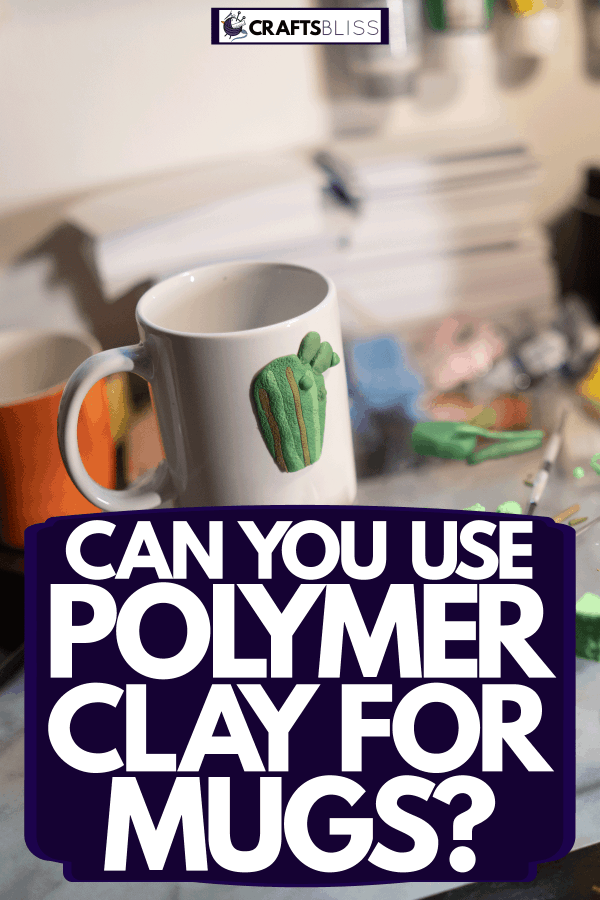
Polymer Clay And Drinkware
Most food-safe drinkware is made from ceramic, glass, stone, or even wood. Although polymer clay is a beloved, soft and pliable medium, it is not recommended for creating drinkware like mugs or tumblers.
Craft lovers of all ages enjoy working with polymer clay to create jewelry, miniature figures, and decorative elements. While polymer clay isn't suitable to make into a mug for drinking or contact with food, you can use it to embellish food-safe mugs.

You can successfully shape and mold shapes, figures, and other clay elements and place them onto ceramic or glass mugs. Food-safe mugs can be baked with polymer clay pressed into place. However, any arranged polymer clay pieces will need to be reattached to the surface of a mug with an adhesive once cooled. It might be tempting to use a sealer to coat any polymer on a mug to prolong its life, but frequent washing will readily remove the sealer.
If you wish to avoid baking polymer clay and using adhesive, consider working with an air-dry brand of clay. For best results, choose a quality, trusted brand of polymer clay like Sculpey or Fimo and experiment with results.
Potential Health Hazards
Because polymer clay is made using PVC and phthalate plasticizers, exercise some caution. Although most brands of polymer clay claim to be non-toxic, frequent handling and baking of this clay require working in a ventilated area and following manufacturer instructions.
Polymer clay should not be baked on surfaces used for food, as the product is not food-safe. Any decorative pieces made from polymer clay should be placed on the mug's exterior or utensil handle and not in an area where that will contact food or drink.
If polymer clay is left in the oven too long or burns because of improper temperatures, the clay may emit noxious chemicals or change colors. Please note, there is ongoing research and speculation regarding associated health risks connected to products containing phthalates, their impact on children, pregnant women, and levels of exposure.
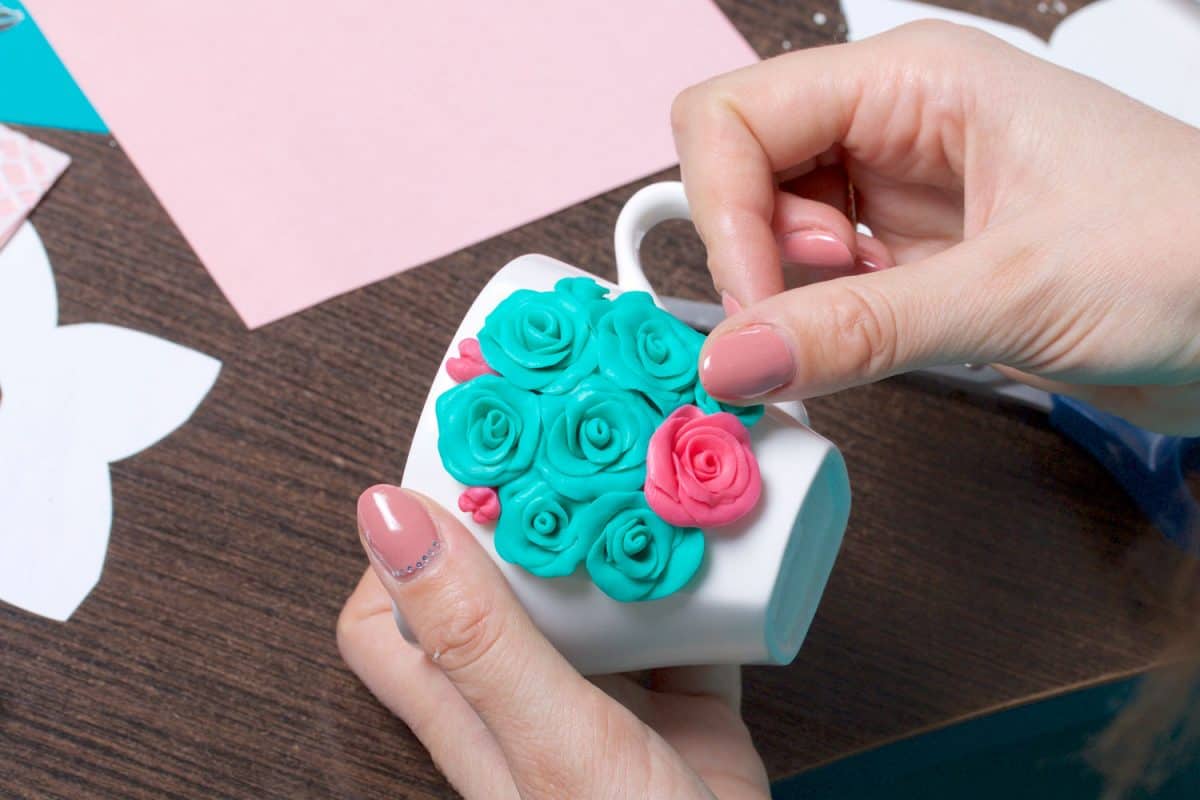
Consider working with polymer clay infrequently, washing hands often, and cleaning surfaces to prevent unwanted contamination or potential health risks. Do not allow young children to ingest polymer clay, cooked or uncooked.
Can You Make Mugs Out Of Polymer Clay?
Polymer clay can be shaped into a wide range of clever items, large and small. However, it is not wise to make mugs out of polymer clay. Drinking mugs receive frequent washing to remove pathogens and are subject to contact with high heat, water, and detergents.
While a ceramic or glass mug would not deteriorate or release chemicals after cleaning, polymer clay should be treated carefully and hand-washed. Avoid placing mugs with polymer clay additions in the dishwasher and look out for cracks or crevices where stains, bacteria, or structural problems might arise.
Check out this classic color Sculpey set on Amazon.
Can You Bake Polymer Clay On A Mug?
It is safe to bake polymer clay on a mug, provided that you work in a ventilated area and follow manufacturer instructions. Do not try to speed through the process of baking polymer clay by turning the temperature higher than recommended or leave the clay in the oven too long.
Burned clay and the emission of potentially hazardous fumes may result. Note, once the clay and mug cool down, any pieces of polymer clay on the mug's surface will likely fall off and not stay put without using adhesive.
How Do You Stick Polymer Clay To Mugs?
Polymer clay can be molded and placed as desired onto the smooth surfaces of mugs. However, many craft lovers will discover that the polymer pieces will fall off of ceramic, glass, and other smooth surfaces once it is cooled.
You can stick polymer clay onto mugs using a little bit of ceramic glue, super glue, or another quality adhesive. Take your time, and only use as much adhesive as is needed, so your project has a clean finish.
Check out this quality super glue on Amazon.
Does Polymer Clay Stick To Glass?
Craft lovers may be able to bake polymer clay on glass, but once the clay cools, it is not likely to stay put on this slippery surface. After baking your polymer clay into whatever form you desire, find a safe, non-toxic adhesive to affix on glass. It is okay to place the clay on glass in the position where you want it to be. But, realize that you will have to wait until your clay pieces and glass is cool enough to safely glue them in place.
Consider using a small amount of super bonding glue to get the job done without sacrificing aesthetics. Polymer clay that has to be baked won't stick without adhesive, but an air-dry form of clay might last longer without needing glue.
Try this helpful glue for bonding polymer clay to glass on Amazon.
Does Polymer Clay Stick To Ceramic?
Polymer clay will not readily stick to the surface of ceramic after it has baked and cooled together in the oven. However, you can use a small amount of super glue or another type of adhesive to keep your decorative elements in place.
A good suggestion is to use ceramic glue to stick polymer clay pieces onto the surface of your mug or object. Air-dry polymer clay will usually stay in its place if you press it lightly onto the surface.
Can You Wash Polymer Clay Mugs?
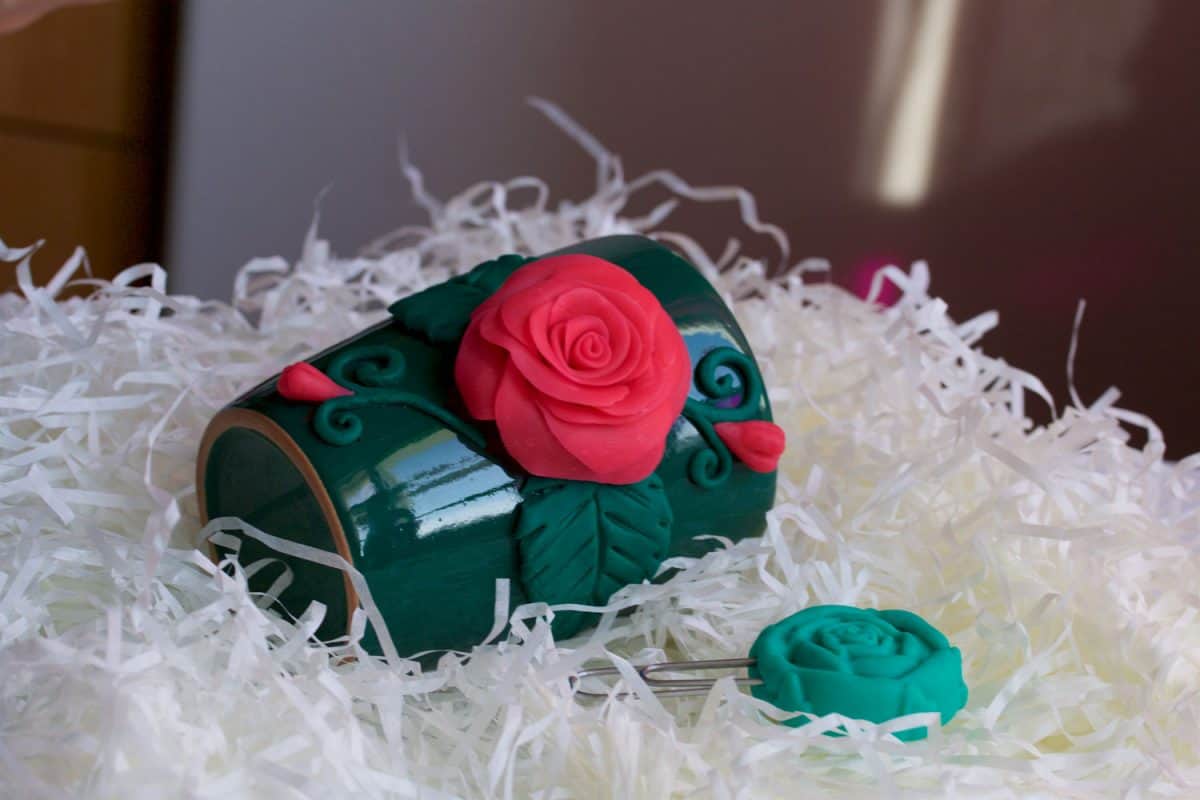
If you have mugs with polymer clay decorating the handle or outside of the cup, it is best to hand wash them carefully. Placing a mug with polymer clay on it in the dishwasher, immersing it in hot water and soap for long periods, or using rough cleaning agents may damage the clay over time.
Using a sealer on the polymer won't necessarily protect the clay from deterioration, cracking, or incurring damage from the washing. Plus, once polymer clay is sealed, it is fairly waterproof.
In Closing
We hope you enjoyed learning more about polymer clay and how you can safely use it to decorate mugs. While polymer clay is not a food-safe choice to create mugs for everyday use, it can be used to embellish and enhance ceramic or glass mugs. Make sure to follow the manufacturer's instructions when working with polymer clay.
Do not overbake clay or use temperatures that are too high, which may cause the clay to burn and emit noxious fumes. Use an adhesive to stick polymer pieces on mug handles or the cup. Ensure the longevity of your polymer clay mugs by hand washing and avoid the dishwasher.
Before you leave, you won't want to miss out on the following articles:




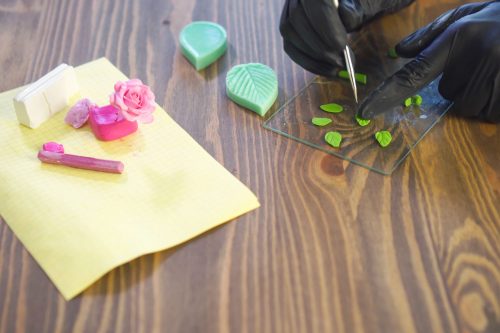


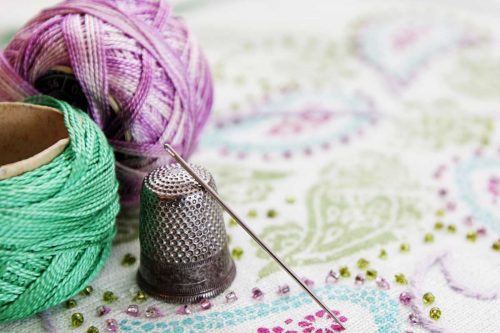
![Read more about the article What Materials Can Be Used To Make Mosaics? [15 Great Options]](https://craftsbliss.com/wp-content/uploads/2021/02/A-gorgeous-circular-mosaic-art-with-using-different-kinds-of-materials-500x333.jpg)
